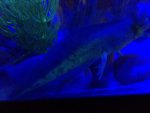I'm not sure what kind of UV tolerance axolotls have but true black lights,(315nm-400nm), emit UVA radiation. In humans this is the same wavelength of light that causes sunburn, and at the lower end of the scale can cause eye damage and possibly increase the development of skin cancer according to recent studies by degrading DNA. I've heard from others for years that UVA/UVB may be harmful to caudata, although I cant say I've seen much research about the subject. I wish there was more being done to learn about this. I personally shy away from it just in case. As a general rule if an animal is nocturnal, aquatic or subterranean,(including leaf litter species), they have no need for UV light because it cannot reach them in any substantial amounts and possibly lack the means to protect themselves from the detrimental effects. Obviously this is the opposite in basking species such as some dart frogs, african bull frogs, iguanas, bearded dragons and such, they have high tolerances and sometimes need UV in some form for metabolic processes.

